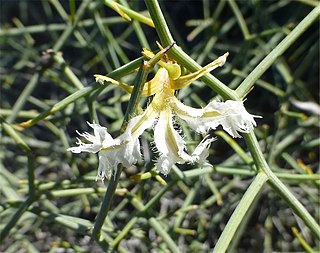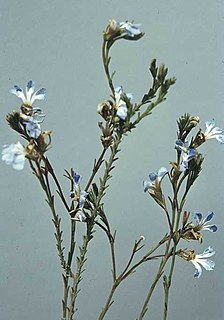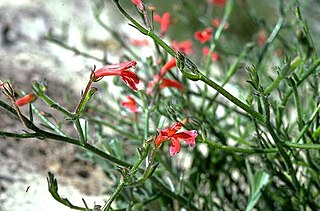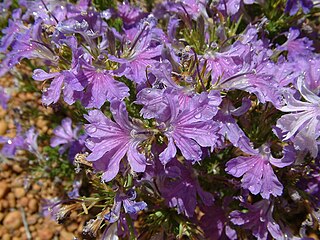
Lechenaultia linarioides, commonly named yellow leschenaultia, is a species of flowering plant in the family Goodeniaceae and is endemic to near-coastal areas in the west of Western Australia. It is a sprawling subshrub with many tangled branches, narrow, crowded, rather fleshy leaves, and yellow and deep pink to purplish red flowers.

Lechenaultia macrantha, commonly known as wreath leschenaultia, is a species of flowering plant in the family Goodeniaceae and is endemic to inland areas of south-western Western Australia. It is a low-lying, wreath-like herb or subshrub with narrow, rather fleshy leaves, and yellow petals with deep pink or red wings.

Phaius tankervilleaevar.australis, also known as the common swamp orchid, southern swamp-orchid, swamp lily or island swamp-orchid, is a species of orchid endemic to eastern Australia. It is an evergreen, terrestrial herb with large, crowded pseudobulbs, large pleated leaves and flowers that are reddish brown on the inside and white outside.

Lechenaultia formosa, commonly known as red leschenaultia, is a species of flowering plant in the family Goodeniaceae and is endemic to the south-west of Western Australia. It is a prostrate or erect shrub or subshrub with crowded, narrow, fleshy leaves and scarlet or orange-red to pale orange flowers.

Lechenaultia divaricata, commonly known as tangled leschenaultia, wirenetting bush or wirebush, is a species of flowering plant in the family Goodeniaceae and is endemic to arid and semi-arid areas of central Australia.

Thelymitra epipactoides, commonly called the metallic sun orchid, is a species of orchid that is endemic to south-eastern continental Australia. It has a single relatively large, leathery leaf and up to twenty large flowers that range in colour from pink to reddish but have a distinctive arrangement of lobes above the anther.

Plectorrhiza brevilabris, commonly known as the small tangle orchid, is an epiphytic or lithophytic orchid endemic to Australia. It has many coarse, wiry roots, between three and nine bright green leaves and up to twenty green, star-shaped flowers with reddish brown markings and a white patch on the labellum. It grows in rainforest on trees, shrubs and occasionally on rocks and occurs on the near coastal ranges of eastern Queensland.
Sarcochilus dilatatus, commonly known as the brown butterfly orchid, is a small epiphytic orchid endemic to eastern Australia. It has up to twelve, thin, leathery, dark green leaves and up to twelve brown or reddish brown flowers with a mostly white and yellow labellum.
Lechenaultia aphylla is a species of flowering plant in the family Goodeniaceae and is endemic to arid parts of inland Australia. It is a glabrous herb or subshrub with spreading branches, almost no leaves, and yellow, tube-shaped flowers.
Lechenaultia chlorantha, commonly known as Kalbarri leschenaultia, is a species of flowering plant in the family Goodeniaceae and is endemic to a restricted area near Kalbarri in Western Australia. It is a subshrub or shrub with many branches, crowded, narrow, fleshy leaves and pale bluish-green, tube-shaped flowers.

Lechenaultia floribunda, commonly known as free-flowering leschenaultia, is a species of flowering plant in the family Goodeniaceae and is endemic to the south-west of Western Australia. It is an openly-branched shrub or subshrub with crowded, narrow, fleshy leaves and compact groups of pale blue to pale mauve or creamy white flowers.
Lechenaultia galactites, commonly known as white leschenaultia, is a species of flowering plant in the family Goodeniaceae and is endemic to the south-west of Western Australia. It is an erect, robust subshrub or shrub with crowded, narrowly oblong to egg-shaped leaves, and white to pale blue flowers.

Lechenaultia heteromera, commonly known as claw leschenaultia, is a species of flowering plant in the family Goodeniaceae and is endemic to the south-west of Western Australia. It is a subshrub with a few wand-like branches, fleshy leaves, and white and pale blue flowers.

Lechenaultia hirsuta, commonly known as hairy leschenaultia, is a species of flowering plant in the family Goodeniaceae and is endemic to the west of Western Australia. It is a straggling, low-lying shrub with few branches, fleshy leaves, and scarlet flowers.
Lechenaultia juncea, commonly known as reed-like leschenaultia, is a species of flowering plant in the family Goodeniaceae and is endemic to the south-west of Western Australia. It is an erect, perennial herb or shrub with crowded, fleshy leaves, and pale blue flowers.

Lechenaultia juncea, commonly known as scarlet leschenaultia, is a species of flowering plant in the family Goodeniaceae and is endemic to the south-west of Western Australia. It is a open, ascending shrub with narrow, crowded, rather fleshy leaves, and scarlet to orange-red flowers.
Lechenaultia lutescens is a species of flowering plant in the family Goodeniaceae and is endemic to inland central Australia. It is a wand-shaped, ascending herb or subshrub with rigid, narrow leaves, and orange-yellow to pale yellow or creamy-white flowers.

Lechenaultia magnifica, commonly known as magnificent leschenaultia, is a species of flowering plant in the family Goodeniaceae and is endemic to the south-west of Western Australia. It is an erect, perennial herb or subshrub with crowded, linear to narrowly lance-shaped leaves, and pink to mauve or purple flowers.
Lechenaultia papillata is a species of flowering plant in the family Goodeniaceae and is endemic to inland areas of south-western Western Australia. It is a diffuse, ascending shrub or subshrub with papillate, crowded, slightly fleshy leaves, and pale blue flowers.
Lasiopetalum laxiflorum is a species of flowering plant in the family Malvaceae and is endemic to the south-west of Western Australia. It is a sticky, straggling subshrub or shrub with many densely hairy stems, egg-shaped leaves, and bright pink and dark red flowers.














